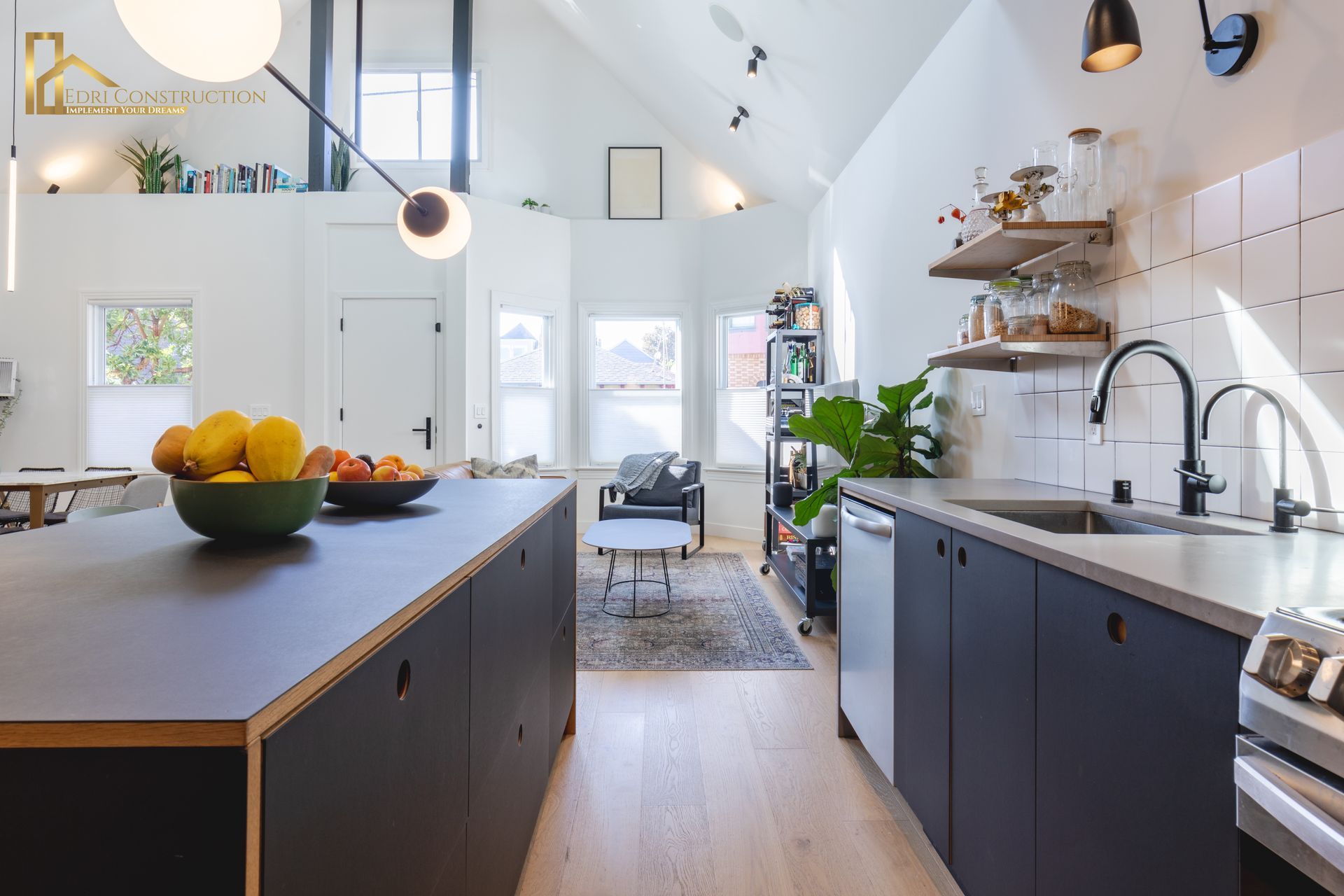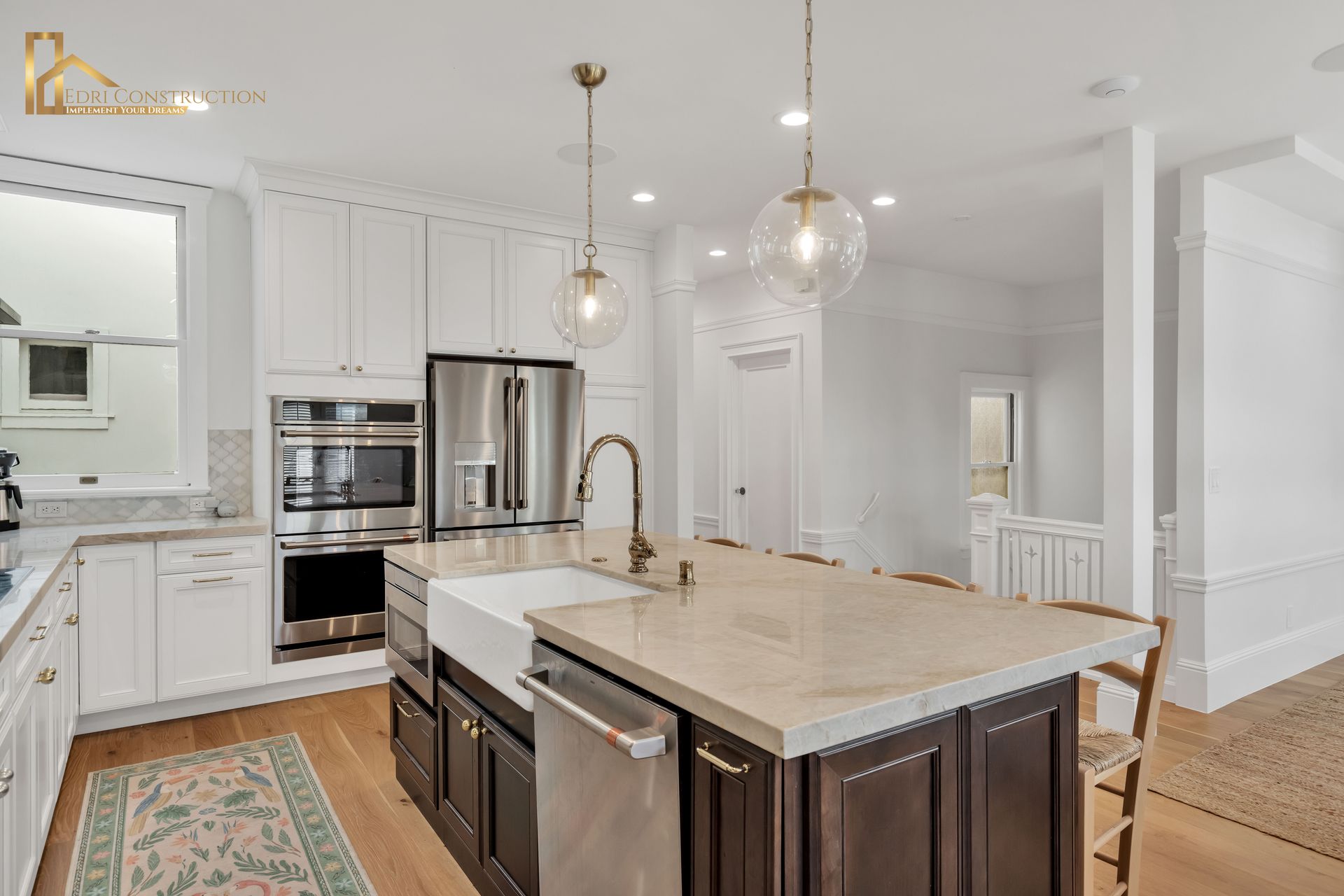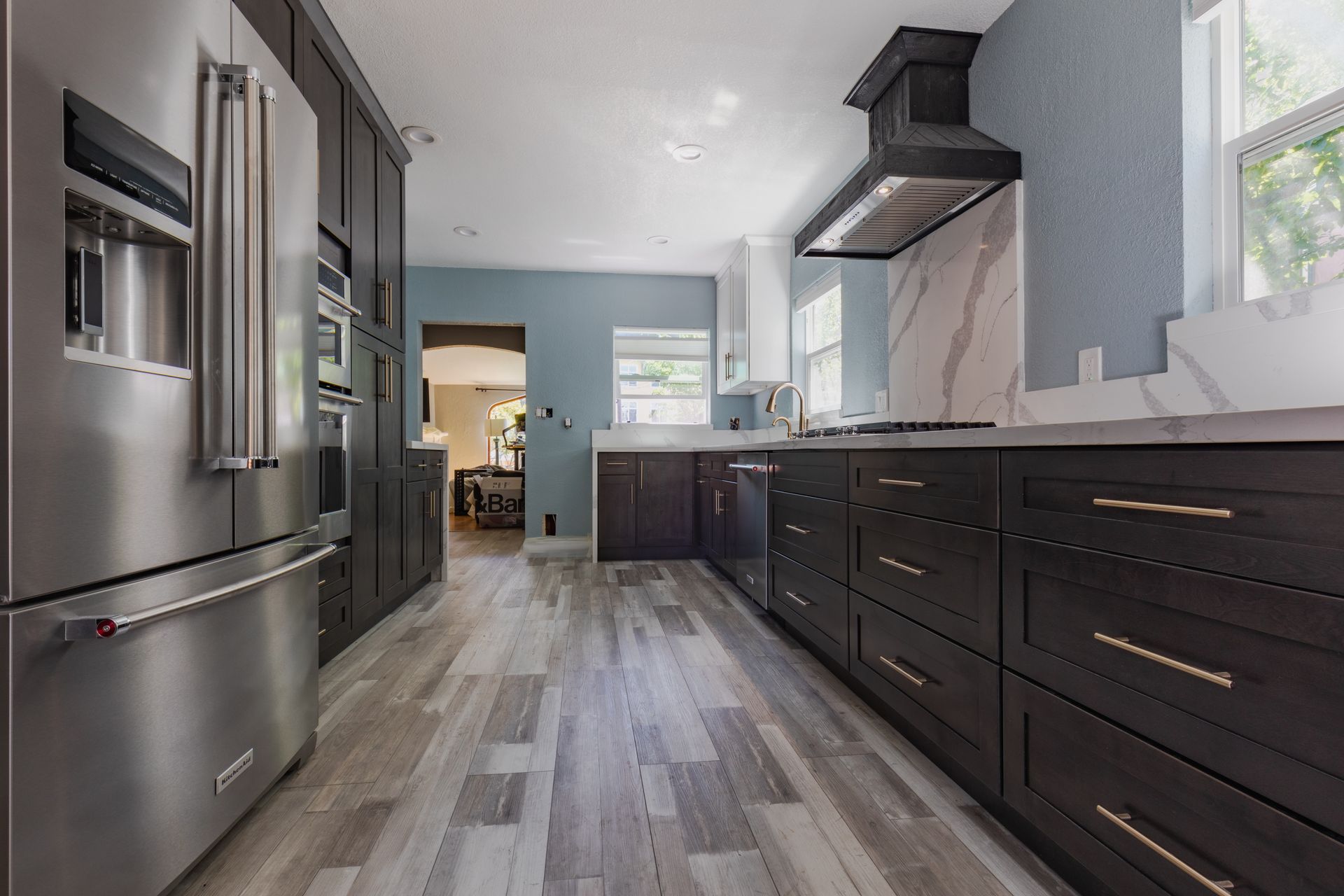How Can I Optimize Storage Space in Kitchen Remodeling?

Introduction
When it's time to revamp your kitchen, one of the main goals is usually to make the most of the available space. A tidy, efficient kitchen not only makes cooking a breeze but also boosts the overall value of your home. Whether you're opting for a major renovation or just a few tweaks, careful planning and clever solutions are essential for getting the most out of your kitchen's layout. In this extensive guide, we'll delve into effective techniques and handy advice to help you optimize storage space in your kitchen remodel.
Your kitchen's storage potential can be maximized with some strategic thinking. Begin by assessing your needs and how you use the space. Do you need more room for pots and pans? Is there a cluttered corner that could be better utilized? Taking stock of these considerations will guide your remodeling efforts.
One smart strategy is to make the most of vertical space. Install tall cabinets that reach all the way up to the ceiling to capitalize on every inch of storage. Additionally, consider adding shelves or racks on the walls to hold items like spices, cookbooks, or decorative pieces, freeing up valuable counter space.
Drawer organizers are also game-changers when it comes to maximizing storage. Use dividers to separate utensils, silverware, and kitchen gadgets, preventing them from becoming a jumbled mess. Customizable drawer inserts are available to fit any drawer size and shape, ensuring a tailored solution for your kitchen's needs.
In addition to these practical solutions, consider incorporating multifunctional furniture into your kitchen design. Choose a kitchen island with built-in storage shelves or cabinets to maximize both prep space and organization. Likewise, opt for dining chairs with hidden storage compartments to stash away rarely used items like seasonal table linens or bulky kitchen appliances.
Assessing Your Needs: Understanding Your Space

Before embarking on a kitchen remodeling journey, it's crucial to begin with a thorough assessment of your kitchen's existing layout and your storage requirements. Start by taking stock of your current cabinets, drawers, and pantry space, while also pinpointing any areas that seem underused or inefficient. Think about your cooking routines, lifestyle, and the number of individuals who regularly use the kitchen. This initial evaluation lays the groundwork for crafting a storage strategy tailored precisely to your needs.
When evaluating your kitchen, pay close attention to the organization of your cabinets and drawers. Are there any items that are difficult to access or frequently cluttered? Assess whether your current storage solutions adequately accommodate your cookware, utensils, and pantry items. Consider implementing organizers, dividers, or pull-out shelves to maximize the usability of your cabinets and drawers.
Collaborate with a kitchen designer or remodeling professional to translate your storage requirements into a cohesive design plan. They can offer valuable insights and expertise to help you make the most of your available space. Together, you can explore a range of storage options, from custom cabinetry to innovative organizational accessories.
Throughout the remodeling process, remain flexible and open to adjustments as needed. As you implement your new storage solutions, periodically reassess their effectiveness and make any necessary tweaks to optimize functionality. By prioritizing thoughtful storage design, you can create a kitchen that not only looks beautiful but also supports your culinary endeavors with efficiency and ease.
Creating a Budget-Friendly Plan

Creating a feasible budget stands as a cornerstone for every kitchen renovation endeavor. It's a roadmap guiding you through the maze of expenses, ensuring you're not caught off-guard. By grasping your financial boundaries, you can effectively plan which upgrades take precedence and distribute funds accordingly. Whether you're a hands-on DIY enthusiast or leaning towards professional aid, understanding the costs involved is paramount.
For the DIY aficionados, there's a treasure trove of cost-effective alternatives waiting to be explored. From savvy choices in cabinets and shelving to ingenious organizational tools, there are numerous ways to achieve a stylish kitchen without breaking the bank. Thrift stores, online marketplaces, and even repurposing items from around the house can yield surprisingly chic results. The key lies in creativity and a willingness to roll up your sleeves.
However, for those opting for professional assistance, thorough research is indispensable. Scout for reputable kitchen remodeling companies and contractors in your vicinity. Seek recommendations, scrutinize online reviews, and request quotes from multiple sources. Remember, the cheapest option may not always be the wisest. Look for a balance between affordability and quality, ensuring your vision is brought to life with skill and precision.
Moreover, it's imperative to consider additional expenses beyond the obvious. Permits, demolition, and disposal costs can sneak up unexpectedly if not factored into the budget from the outset. Obtaining the necessary permits ensures your renovation is compliant with local regulations, avoiding potential legal hassles down the line. Demolition and disposal expenses vary depending on the scale of your project, so it's wise to allocate a buffer for these eventualities.
When crafting your budget, transparency is key. Be realistic about what you can afford and where you're willing to compromise. Prioritize upgrades based on your needs and lifestyle, allocating funds accordingly. For instance, if you're an avid cook, investing in high-quality appliances might take precedence over extravagant countertops. Similarly, if space is at a premium, focus on maximizing storage efficiency with clever organizational solutions.
Setting a realistic budget is the cornerstone of any successful kitchen remodeling project. Whether you're a DIY enthusiast or seeking professional assistance, understanding the full scope of expenses is essential. Factor in everything from materials and labor costs to permits and disposal fees, and don't forget to leave room for contingencies. With careful planning and prudent decision-making, you can transform your kitchen into the heart of your home without breaking the bank.
DIY vs. Professional Assistance

When it comes to remodeling your kitchen, deciding whether to take on the project yourself or hire professionals depends on several key factors. Your level of skill, the amount of time you have available, and the complexity of the project all play a role in making this decision.
DIY projects offer flexibility and the potential for cost savings. By doing the work yourself, you have control over every aspect of the project, from the design to the materials used. Plus, you can work on your own schedule, fitting the project around your other commitments. However, DIY projects can also be time-consuming and challenging, especially if you lack experience in home renovation. You may find yourself facing unexpected obstacles or needing to learn new skills along the way, which can extend the timeline and increase frustration.
On the other hand, hiring a professional kitchen remodeling company or contractor can streamline the process and ensure high-quality results. Professionals have the expertise and experience to tackle even the most complex projects, and they're familiar with local building codes and regulations. This means you can trust that the work will be done safely and up to standard. Additionally, hiring professionals frees up your time and energy, allowing you to focus on other priorities while the experts handle the renovation.
When deciding whether to DIY or hire professionals, it's important to honestly assess your own abilities and resources. Do you have the necessary skills and knowledge to complete the project to your satisfaction? Do you have the time to devote to the project, or would your time be better spent on other pursuits? Consider your comfort level with tasks like plumbing, electrical work, and carpentry, as well as your budget for materials and labor.
If you're leaning towards DIY but feel unsure about certain aspects of the project, don't hesitate to seek expert advice. Many home improvement stores offer workshops and classes on topics like tile installation, cabinet refacing, and countertop replacement. You can also consult online tutorials, forums, and how-to guides for step-by-step instructions and troubleshooting tips. By arming yourself with knowledge and seeking assistance when needed, you can increase your chances of success and create the kitchen of your dreams.
Strategic Design Solutions
Efficient storage design is essential for optimizing space in any setting, particularly in the kitchen. A well-thought-out approach begins with utilizing vertical space to its fullest potential. Tall cabinets and shelving units are excellent for making use of often overlooked areas. By reaching upward, you unlock valuable storage real estate that might otherwise go unused.
Deep drawers and pull-out shelves are invaluable additions, offering convenient access to pots, pans, and small appliances. This minimizes clutter on countertops, creating a cleaner and more organized cooking environment. Imagine effortlessly gliding open a drawer to retrieve the perfect saucepan or spatula, all without rummaging through crowded cabinets.
Picture a newly remodeled kitchen where every cabinet, drawer, and shelf is meticulously organized to accommodate your cooking essentials. With thoughtfully designed storage solutions in place, you'll find meal preparation becomes more efficient and enjoyable. No longer will you waste time searching for misplaced items or battling cluttered countertops.
The secret to maximizing storage space lies in thoughtful design and strategic organization. By capitalizing on vertical space, incorporating innovative storage solutions, and customizing design to fit your needs, you can transform your kitchen into a functional and organized oasis. Say goodbye to clutter and hello to a space where everything has its place.
Streamlining the Process: A Remodeling Checklist

Staying organized during a remodeling project is key to achieving your desired results without unnecessary stress or delays. To help you navigate through the process smoothly, it's essential to have a comprehensive checklist that outlines every step, deadline, and material requirement. From the initial demolition to the final touches of plumbing and electrical work, breaking down the project into manageable tasks will keep you focused and on track.
Once the demolition is complete, it's time to move on to the installation phase. This includes everything from laying down new flooring to installing cabinets and countertops. Coordinate with your contractors and suppliers to ensure timely delivery of materials and schedule installation dates accordingly.
As you progress through the project, don't forget about the plumbing and electrical work. Whether you're relocating fixtures or upgrading wiring, these tasks require careful planning and execution. Make sure to consult with licensed professionals to ensure compliance with building codes and safety standards.
Utilizing Every Inch: Condo Kitchen Remodeling

One approach is to invest in furniture pieces that serve multiple purposes. Consider an extendable dining table that can easily accommodate guests when needed but can also be tucked away to save space during everyday use. Likewise, a kitchen island with built-in storage provides extra room for utensils, pots, and pans, while also offering additional countertop space for meal preparation.
When it comes to appliances, prioritize those designed specifically for smaller kitchens. Look for slim refrigerators that can fit snugly into tight corners, stackable washer-dryer combos to maximize laundry space, and wall-mounted folding tables that can be stowed away when not in use. These space-saving appliances not only free up valuable square footage but also contribute to a more streamlined and efficient kitchen layout.
Customization is key when dealing with odd angles and corners in a condo kitchen. Invest in custom cabinetry and shelving solutions that make the most of every inch of available space. Consider installing shelves that wrap around corners or cabinets with pull-out drawers to ensure no space goes unused. By tailoring your storage solutions to fit the unique layout of your kitchen, you can optimize storage capacity while maintaining a clean and organized environment.
In addition to furniture and appliances, lighting can also play a crucial role in maximizing space in a small kitchen. Opt for under-cabinet lighting to illuminate countertops and workspaces, creating the illusion of a larger and brighter room. Pendant lights above the kitchen island can also help to visually define the space while adding a touch of style and elegance.
Finally, don't overlook the importance of decluttering and organization in a small kitchen. Invest in storage containers and organizers to keep countertops clear and cabinets tidy. Consider implementing a rotating system for pantry items to ensure nothing gets lost in the back of the cupboard. By keeping clutter to a minimum and maintaining an efficient organizational system, you can make the most of your condo kitchen's limited space while still enjoying all the amenities and comforts of a larger kitchen.
Conclusion
In summary, enhancing storage capacity stands as a pivotal aspect of kitchen renovation, demanding meticulous planning, thoughtful design, and effective implementation. Through a thorough assessment of your requirements, the formulation of a budget-conscious strategy, and exploration of both DIY and professional avenues, you can embark on a remodeling endeavor that breathes new life into your kitchen, rendering it both functional and organized. By integrating strategic design solutions, adhering to a remodeling checklist for seamless progress, and embracing inventive concepts tailored to condominium kitchens, you ensure every nook and cranny of your space reaches its utmost potential. Armed with the right mindset and approach, you can realize the kitchen you've long envisioned, all the while augmenting the long-term value of your dwelling.
FAQ: Maximizing Storage Space in Kitchen Remodeling
What are some effective ways to maximize storage space in a kitchen remodel?
Incorporating tall cabinets, deep drawers, pull-out shelves, and overhead racks are effective ways to maximize storage space in a kitchen remodel. Additionally, utilizing corner cabinets with lazy Susans or pull-out trays and customizing storage solutions to fit specific needs can enhance organization and functionality.
How can I determine the storage needs for my kitchen remodeling project?
Assess your kitchen's current layout, take note of existing storage options, and consider your cooking habits, lifestyle, and the number of people using the kitchen regularly. This evaluation will help you identify underutilized areas and determine the type and amount of storage needed for your remodel.
What should I include in my kitchen remodeling budget?
When creating a budget for your kitchen remodel, consider expenses such as materials, labor, permits, demolition, disposal, and any unforeseen costs. DIY enthusiasts should also factor in the cost of tools and equipment, while those hiring professionals should research kitchen remodeling companies and contractors in their area.
Is it better to tackle a kitchen remodeling project as a DIY or hire professionals?
Whether to tackle a kitchen remodeling project as a DIY or hire professionals depends on factors such as skill level, time availability, and project complexity. DIY projects offer flexibility and cost savings but may require more time and effort, while hiring professionals ensures quality workmanship and adherence to building codes.
What are some strategic design solutions for maximizing storage space?
Strategic design solutions for maximizing storage space include incorporating tall cabinets, deep drawers, pull-out shelves, overhead racks, and utilizing corner cabinets with lazy Susans or pull-out trays. Customizing storage solutions to fit specific needs and space constraints will enhance functionality and organization.
How can I stay organized during the kitchen remodeling process?
Creating a comprehensive remodeling checklist outlining all tasks, deadlines, and materials needed will help you stay organized during the kitchen remodeling process. Coordinate with contractors, suppliers, and other professionals involved to ensure timely completion and minimize delays.
What are some space-saving ideas for remodeling a condo kitchen?
Space-saving ideas for remodeling a condo kitchen include opting for multi-functional furniture pieces, such as extendable dining tables and kitchen islands with built-in storage. Explore space-saving appliances and fixtures designed specifically for smaller kitchens and customize cabinetry and shelving to fit odd angles and corners.
How can I make the most of vertical space in my kitchen remodel?
Making the most of vertical space in a kitchen remodel involves incorporating tall cabinets, shelving units, overhead racks, and hanging hooks for pots, pans, and utensils. These solutions help capitalize on unused areas and maximize storage capacity without taking up additional floor space.
What are some cost-effective alternatives for kitchen remodeling?
Cost-effective alternatives for kitchen remodeling include DIY projects using affordable materials and tools, exploring pre-owned or discounted appliances and fixtures, and repurposing existing cabinetry with a fresh coat of paint or new hardware. Researching budget-friendly options and prioritizing upgrades can help you achieve your remodeling goals within your financial means.
How long does a typical kitchen remodeling project take to complete?
The duration of a typical kitchen remodeling project depends on various factors, including the scope of work, size of the kitchen, availability of materials, and contractor schedules. On average, a kitchen remodel can take anywhere from several weeks to a few months to complete. It's essential to establish realistic timelines and communicate effectively with contractors to ensure timely completion of the project.










